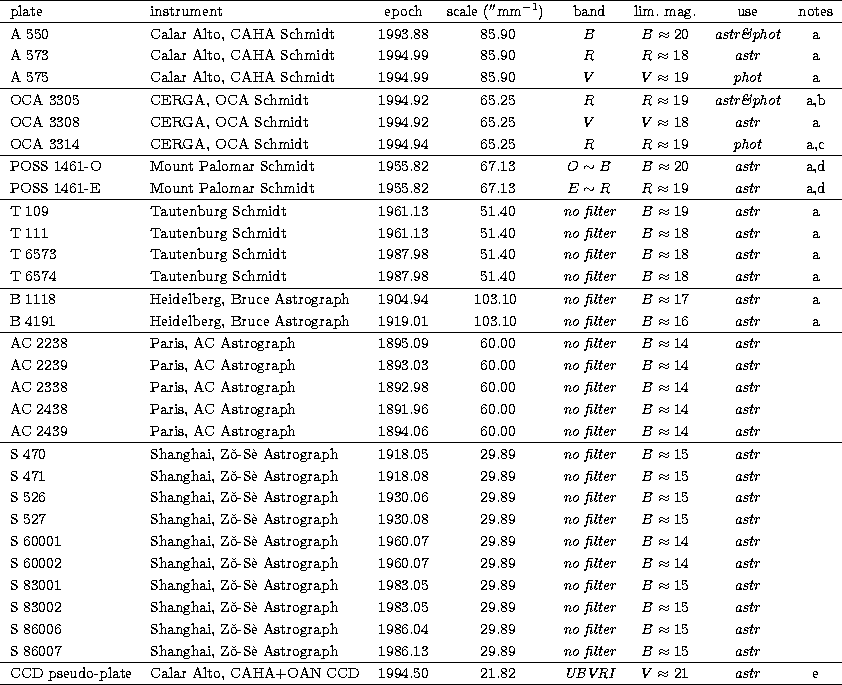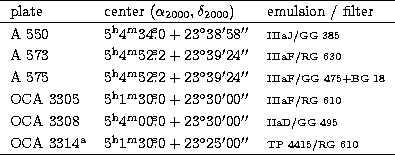
Notes:
|

Notes:
|
A set of six modern epoch Schmidt plates were obtained specifically
for this work. Three of them were taken at Centro Astronómico
Hispano-Alemán (CAHA, Calar Alto, Almería, Spain), and the other
three at Côte d'Azur Observatory (OCA, CERGA, France). Table
2 summarizes some data about these plates. All of them
were well centered in the clusters area. The scanned zone of these
plates was a rectangle with center at the star PPM 94015, covering 12 cm
![]() 16 cm (
16 cm (![]() ) in
CAHA plates, and 13 cm
) in
CAHA plates, and 13 cm
![]() 13 cm (
13 cm (![]() )in OCA plates. The filter-emulsion combinations permit a
good reproduction of Johnson's B, V and R bands.
)in OCA plates. The filter-emulsion combinations permit a
good reproduction of Johnson's B, V and R bands.
CAHA plates were kindly exposed and developed by J. Zamorano and Ó. Alonso (A 550), and by K. Birkle (A 573 and A 575). They are stored at the Departament d'Astronomia i Meteorologia of the Universitat de Barcelona.
OCA plates were obtained at CERGA Schmidt camera to the request of
J. Guibert. They are stored at the clichothèque of the Centre
d'Analyse des Images (Observatoire de Paris). Côte d'Azur plate
OCA 3305 showed to be the deepest and finest from the astrometric and
photometric points of view among our whole set of plates and, thus, it
was selected as master plate for our ICOA implementation. The plate
OCA 3314 is film-based. In Sect. 5.2 we discuss the limits
of its astrometric performance compared to classical glass plates.

|
The studied area is contained in POSS I field number 1461. POSS plates 1461 in the O (blue) and E (red) bands were obtained in 1955 and are very deep. It has been shown that good quality copies of POSS plates are capable of giving good astrometric accuracy (Hunstead 1973). Our glass copies of POSS 1461 O and E plates are very clean (no scratches nor drops are apparent), the emulsion and developing seem very uniform and the photometric calibration of the density of stellar images (Sect. 3) shows that the original dynamic range and limiting magnitude have been well preserved.
Both plates are centered at the position ![]() . The scanned
area was a rectangle of 10 cm
. The scanned
area was a rectangle of 10 cm ![]() 13 cm (
13 cm (![]() )centered on the star PPM 94015.
The filter-emulsion combination of POSS plates are similar to
Johnson's B and R.
)centered on the star PPM 94015.
The filter-emulsion combination of POSS plates are similar to
Johnson's B and R.
The plate files of the Astrophysical Observatory of Potsdam
(Germany) were made available for this study by E. Schilbach. Four
Schmidt plates taken with the big Tautenburg Schmidt camera were
selected: two at epoch 1961 (T 109 and T 111), and two at epoch 1987
(T 6573 and T 6574). The older pair is centered at ![]() ,while the center for the other pair is
,while the center for the other pair is ![]() . In all cases, the
scanned area was a rectangle of 12 cm
. In all cases, the
scanned area was a rectangle of 12 cm ![]() 15 cm (
15 cm (![]() ) around the star PPM 94048.
) around the star PPM 94048.
A slight elongation of stellar images was seen on some Tautenburg plates, probably due to guiding errors.
Heidelberg files contain a number of ancient plates centered near the Ecliptic in Taurus. Four of them were selected because they contained the whole cluster area, and their image quality was good: B 1118 (epoch 1904), B 1386 (epoch 1905), B 3563 (epoch 1914) and B 4191 (epoch 1919). Unfortunately, huge problems arose for the measurement of several of these plates. Probably due to glass bending, B 1386 and B 3563 led to serious focusing difficulties in the device, and it was not possible to obtain useful data from them.
Plates B 1118 and B 4191 were successfully measured. The first one
was not only the oldest, but also the deepest and finest in image
quality among the four Bruce plates. B 1118 is centered at
![]() . B 4191 is centered at
. B 4191 is centered at
![]() . The measured zone was a square of
8.5 cm
. The measured zone was a square of
8.5 cm ![]() 8.5 cm (
8.5 cm (![]() )around the star PPM 94013 in both cases.
)around the star PPM 94013 in both cases.
The Astrographic Catalog has been re-reduced and published at the United States Naval Observatory (Urban & Corbin 1996; Urban 1997). They used the original plate measurements and determined new plate constants taking modern catalogues as reference. In spite of having been manually measured, the original AC data have shown to be useful and of good quality. Recently, the combination of AC positions with Tycho catalogue (ESA 1997) allowed a noticeable improvement of Tycho proper motions (Urban et al. 1997).
S.E. Urban provided us with the files containing the original AC
positional and photometric manual measurements from the individual AC
plates close to the cluster area. Five AC plates from Paris zone were
very suitable for our work. One of them (AC 2338) is almost centered
on the clusters, while four additional plates (AC 2238, AC 2239, AC
2438, AC 2439) overlap with the former in a corner-on-center
disposition. Each plate covers a field of view of ![]() .These data are the oldest ones used in our proper motion determination
(epochs from 1891 to 1895, see Table 1). The absolute
accuracy of the original positions in Paris zone is reported to be of
.These data are the oldest ones used in our proper motion determination
(epochs from 1891 to 1895, see Table 1). The absolute
accuracy of the original positions in Paris zone is reported to be of
![]() by Eichhorn (1974), and
by Eichhorn (1974), and
![]() by Urban (1997).
by Urban (1997).
A total number of ten plates from Zo-Sè Astrograph (Shanghai,
China) were used in our study. These plates are 24 cm ![]() 30 cm in
size, which corresponds to
30 cm in
size, which corresponds to ![]() with the
plate scale of the instrument (29.89'' mm-1). All of them were
well centered in the cluster region and non-filtered. The old epoch
plates (1918 and 1930) were used by Li (1954) in his proper motion
determination in the NGC 1750 area.
with the
plate scale of the instrument (29.89'' mm-1). All of them were
well centered in the cluster region and non-filtered. The old epoch
plates (1918 and 1930) were used by Li (1954) in his proper motion
determination in the NGC 1750 area.
All ten Shanghai plates were measured with a PDS machine in the
Dominion Astrophysical Observatory (Canada) and the measurements were
supplied for the present work by two of us (K.P.T. and J.L.Z.).
The files
contained, for each star, the sequence number of the measurement, star
coordinates, their estimated errors and the densities of the star images
(in the form of instrumental magnitude). The estimated errors in the
positions are usually around or below 1 ![]() m for well measured stars.
m for well measured stars.
A total of 15 stars were re-measured three times along the plate scan process, in order to monitor possible drifts. These "drift stars'' were measured also as program stars. So, a total of four measurements were available for each drift star on each plate. Although the output data do not contain time information, the sequence number of the measurements can be used as a time indicator. For each drift star, taking one position as reference and plotting the coordinates change as a function of the sequence number, slight drifts were detected in some cases. Although most of these drifts were below the formal accuracy of the measurements, in several plates the tendency was so clear that it seemed convenient to apply a linear correction.
The whole set of CCD fields from Paper I was assembled into a CCD pseudo-plate. This plate should not be confused with the "global CCD frame'' described in Paper I. That global frame was composed by simple transformation of contiguous fields using the stars in the overlap areas, and was used for computing approximate equatorial coordinates for the photometric catalogue in the FK5 reference system.
But the present CCD pseudo-plate is produced in a more sophisticated way, avoiding the intrinsic inaccuracies of tranformations through slight overlaps. Because of its deep link to the treatment of inter-plate magnitude equation, we describe the construction and properties of the CCD pseudo-plate in Sect. 6.2.2.
This device has a superb optical and mechanical performance
(Guibert et al. 1990). It uses a quartz-iodine illuminating source, whose
transmitted light is detected by a reticon, 1024 pixels large, with a
pixel size of 10 ![]() m. The plate is moved under the light source
during the scanning process. Our plates were scanned in the smallest
pixel mode, 10
m. The plate is moved under the light source
during the scanning process. Our plates were scanned in the smallest
pixel mode, 10 ![]() m. The repeatability of the measurements with the
MAMA is around of 0.2
m. The repeatability of the measurements with the
MAMA is around of 0.2 ![]() m, and the absolute accuracy of the
measurements is 0.6
m, and the absolute accuracy of the
measurements is 0.6 ![]() m (Soubiran 1992).
m (Soubiran 1992).
MAMA can operate in two measuring modes (Berger et al. 1991): pavé and zone. In the pavé mode, an input list of program objects is provided to the machine, and it scans a small plate area around the expected position of each of them. In the zone mode, an extended, continuous region of the plate is specified and scanned. In our case, the pavé mode was used for the scanning of a list of photometric standard stars (Sect. 3.1) inside the clusters area, and also for recording the PPM (Röser & Bastian 1989) stars present on the whole plate with the aim of performing a preliminary astrometric reduction. The plate areas specified in previous subsections for each plate were scanned in zone mode.
In pavé as well as in zone mode, the resulting digital images were treated with a multi-threshold object-detection and reconstruction algorithm. A maximum number of 9 thresholds was used for our plates. The lowest threshold was chosen to be 3 times the standard deviation of the sky background. For each density threshold, the algorithm produces an output list of detected objects with photocenter position, object area, integrated flux density and various morphological parameters. The flux determinations are automatically corrected for the local sky background. A second algorithm applied to the output files performs the cross-identification and grouping of data for each object detected on different thresholds. In this step, an identification number is assigned to each individual object.
In order to avoid noise in the data files, objects detected only at the lowest thresholds (1 and/or 2) were suppressed. Since the object position at each threshold is identified with the photocenter, the object area has to be large enough to provide a good accuracy. Following Soubiran (1992), we ignored all entries having an area smaller than 10 pixels.
The pavé mode detection of PPM stars on the whole plate allows to determine the object positions in the FK5 reference system. In this way, for each scanned plate we got a preliminary astrometric catalogue that allowed us to perform initial cross-identifications between different plates (Sect. 4).
Copyright The European Southern Observatory (ESO)